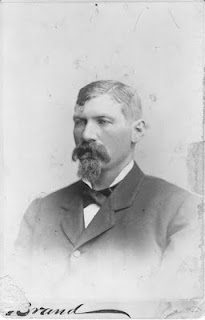
In 1866, a young man ran away from home, emigrated to American with the proverbial $1 in his pocket and went west to find his fortune. This is hardly a unique tale in America's western expansion, or even in the history of humanity. This young man, my great-great grandfather Big Bill Daley, made his way west as a bull whacker, one of the hardy breed who guided freight wagons destined for far-distant Army posts.
The Army was completely dependent on the bull whackers to supply their every need and freighting was a way for men to go west without the cost of a horse or a wagon. One freighting company employed 4,000 men and 40,000 oxen during a peak year.
The term bull whacker accurately described the occupation. Bull was the plains term for an ox, his castrated state not an issue, and the whacker part self-evident. From late March to May, freighters left the western-most depot - usually Nebraska City, Nebraska - in droves, starting out as soon as snow started to melt, hopefully ahead of the emigrants whose stock would consume most of the good forage. Their payloads included coffee, sugar, beans, flour, bacon, salt, crackers, condensed milk, dried vegetables, boots, shoes, blankets, uniforms, whiskey, oil, and anything else the sutler or fort commander might request.
An ideal wagon train was comprised of 25 wagons, 330 oxen, eight to 10 saddle animals (usually mules) and 29 men. The upper limit on wagons was set by the maximum number of oxen that could graze and water within suitable distances from the camp when on the trail. A freight train consisted of a wagon boss, assistant wagon boss, freighters, night herder and clerk. The wagon boss was responsible for the train and cargo and safety of the men and animals. The assistant wagon boss supervised the progress of the wagon train. The night herder watched over the oxen at night and slept in a wagon during the day. The (optional) clerk kept track of the pay and the payload. The remainder were bull whackers.
Dressed in the "uniform" of the trade - a broad brimmed hat, flannel shirt, pants, heavy boots, a rubber coat for inclement weather and armed with a pistol and knife - bull whackers walked beside their oxen, making an estimated 16 to 18 miles a day. The wagons were either singles, pulled by 10 to 16 oxen and hauling 2,000 pounds of goods or lighter, more maneuverable tandem wagons, pulled by 12 oxen and hauling 7,000 - 8,000 pounds.
Bull whackers started their day at 3 a.m. with the harnessing of the teams. They then traveled until mid-morning, when they stopped to graze the oxen and have a breakfast of bacon, beans, black coffee and a heavy bread. After eating, they repaired wagons and cared for injured oxen. In early afternoon, they set out until evening, when the would stop, eat bacon, beans, black coffee and heavy bread and turn care of the oxen over to the night herder. The bull whackers were then free to gamble, fight, sweat and drink.
Once at their destination, bull whackers were paid, sometimes in cash, sometimes in script and released. Many found employment with other wagon trains, as civilian contractors at the forts, or went on to the gold fields, ranches, or some other enterprise. Some drove empty wagons east.
After 1868 when the transcontinental railroad was completed, bull whackers continued their profession by freighting goods to army posts not located on rail lines. Of the thousands of freighters who travel west, some returned east. Others died in any number of uncomfortable ways. But many, like Bill Daley, became heads of the great or humble families all over the west. Their contribution is overlooked in American popular culture but is part of all westerners' heritage.
No comments:
Post a Comment